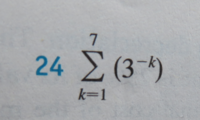I get the little loops of folly. Been there many times myself.
But there are several morals to this story.
(1) Unless you ask someone who has the same type of calculator you are using, it is very difficult to answer questions that involve “why did my calculator give me this answer.”
(2) When someone goes to the trouble to write out a boring arithmetic problem validating your calculator’s answer, the calculator is almost certainly doing what the manual says will happen upon pressing some sequence of keys. So if your calculator starts at k = 1, that is fine. If the formula that you have memorized starts with k = 1, that is fine so long as you remember the formula and when it applies. But math is not so limited. There can be a formula that starts at k = 0. What your calculator does is fixed in electronics; those electronics do not limit math.
(3) Formulas are dangerous. I do not burden my memory with lots of formulas. I have memorized a few that are easy to remember and that I fully understand and can prove. And I disclosed the general formula that I used. It is easy to remember.
[MATH]\sum_{k=0}^n r^k = \dfrac{1 - r^{(n+1)}}{(1 - r)} = 1 + \sum_{k=1}^n r^k.[/MATH]
[MATH]\therefore \sum_{k=1}^n = \dfrac{1 - r^{(n+1)}}{1 - r} - 1 = \dfrac{r - r^{(n + 1)}}{1 - r} = \dfrac{r(1 - r^n)}{1 - r} = r * \dfrac{1 - r^n}{1 - r}.[/MATH]
So you remembered the formula correctly and are mis-remembering it now. (If you do not fully understand why a formula is what it is, you are apt to mis-remember it.)
But your formula is for positive powers, such as 1 to 7, not negative powers, such as -1 to -7. To make your powers positive, your r must be (1/3) rather than 3.
[MATH]\dfrac{1}{3} * \dfrac{1 - \left ( \dfrac{1}{3} \right )^7}{1 - \dfrac{1}{3}} = \dfrac{1}{3} * \dfrac{\dfrac{2186}{2187}}{\dfrac{2}{3}} = \dfrac{1093}{2187}.[/MATH]




